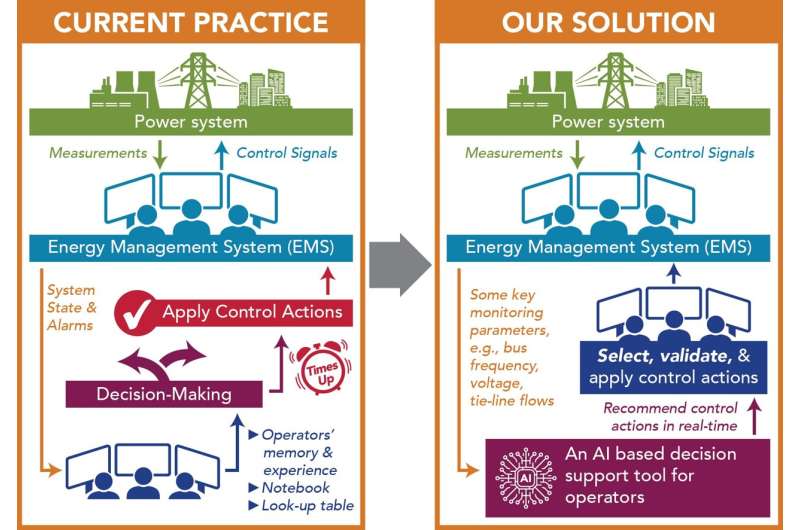Industry collaboration powers new generation of grid emergency control technology

Grid operators face big challenges and big opportunities when it comes to managing through emergency conditions that disrupt power service. The increasing number of power outages in the United States cost an estimated $30–50 billion and affect millions of customers each year. The challenge and the opportunity both lie in optimizing power system responses when the unexpected happens. Optimization can minimize the effects of these events.
Researchers at Pacific Northwest National Laboratory (PNNL) are collaborating with partners at Google Research, PacifiCorp, and V&R Energy to develop a real-time adaptive emergency control system to safeguard the grid against costly disturbances from extreme weather and other disruptive events. The technology significantly improves on existing methods, which require grid operators to rely on offline studies to determine appropriate system responses during real events.
However, these events do not always unfold as we expect, and grid conditions can change in fractions of a second. Some online tools considered by current standards to operate in "real time" can trail behind actual events happening in the system by five to 15 minutes.
The scalable High-Performance Adaptive Deep-Reinforcement-Learning-based Real-Time Emergency Control (HADREC) platform—being further developed and tested under a three-year investment from the Department of Energy's Advanced Research Projects Agency–Energy (ARPA-E)—uses a type of artificial intelligence (AI) called deep reinforcement learning, alongside high-performance computing, to automate decision-making and system responses within seconds of a disturbance.
Deep reinforcement learning improves on conventional reinforcement learning in its ability to better scale and quickly and effectively apply existing patterns to a real event's unpredicted problems across thousands of system assets. Initial results show the HADREC technology will help reduce system reaction time 60-fold and improve system recovery time by at least 10%. This helps prevent cascading disruptions, thus allowing more efficient and resilient grid operation.
A three-year plan toward real-world system demonstration
The project's collaborators are realizing the benefits of combining diverse perspectives and expertise from all angles of the problem while working efficiently toward a solution. During year one, the team established performance methods and benchmarks for the HADREC algorithms and began testing them using a mock system the size of the Texas grid. Once satisfied with algorithm performance, they moved testing to a more realistic, larger-scale system.
Now, as they enter year three, the team will focus on demonstrating the technology using actual utility and grid data. By the end of the project in 2022, the technology will be developed and sufficiently tested for integration with a real production system.
"Sometimes grid operators have traditional ways to solve a particular problem, but it is difficult and time-consuming and they still may not arrive at a feasible and effective answer," said PNNL electrical engineer and collaborator Qiuhua Huang. "An ARPA-E project like this one pulls parties together to guide development from multiple perspectives, and combine that with the benefit of strong research capabilities to solve real-world problems more efficiently and effectively."
Tapping the experience of industry and a national laboratory
Working alongside PNNL on the project are utility vendor and technology developer V&R Energy, investor-owned utility PacifiCorp, and a Google Research team with expertise in machine and reinforcement learning. Each holds a unique piece of the puzzle.
Based in Portland, Oregon, PacifiCorp is one of the largest grid operators in the western United States. "The benefit for us in partnering with a national laboratory such as PNNL is the contribution of new ideas, techniques, and tools to solve increasingly complex challenges," said Song Wang, PacifiCorp transmission planning engineer. "In turn, we are able to share information with our research partners about the specific challenges we face in the utility industry to help effectively focus the team's efforts toward solution development."
For V&R Energy, the goal is to help provide effective solutions to the problems PacifiCorp and other grid operators face. "We have power systems that are under various stress conditions, which include different behavior patterns due to interconnection of renewable generation on a larger scale than before," said co-founder Marianna Vaiman. "We also see a lot of severe weather events, like wildfires and hurricanes, when cascading outages can take place in a very short time. What we're trying to achieve through this project is very fast, robust, and reliable control of the system in case severe events occur."
The Google Research team has also lent their expertise, successfully applying deep learning and reinforcement learning to the project. "Our goal is to work on long-term, ambitious problems across a wide range of important topics. We explore opportunities to leverage our unique capabilities for social good, and this project is well-aligned with our work and mission," said Jie Tan, staff research scientist and tech lead manager at Google Research.
The HADREC collaboration is ultimately focused on decreasing the impact of severe events or faults happening in the power system by providing fast, accurate mitigation measures that alleviate conditions that threaten grid stability and reliability. The solution to this problem is becoming increasingly important as the mix of energy resources continues changing in our country and worldwide and extreme events are increasing in frequency. "What we're doing with this project is becoming even more important now than when we first started it," said Vaiman. "And putting our heads together as we are will get us there quicker and with a more accurate answer."
The HADREC team has already developed a set of open source analytic software and tools for developing novel, AI-based intelligent grid emergency control applications. These applications can help grid operators safeguard the reliability of their networks against natural and manmade threats. The team plans to make the applications available for licensing by the end of 2022. Licensing the software and tools will enable utilities and system operators to develop new emergency control solutions that are tailored to their own unique needs and challenges.















